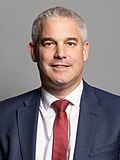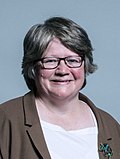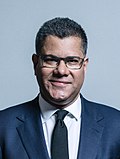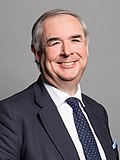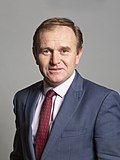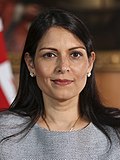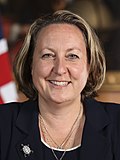Top Qs
Timeline
Chat
Perspective
Second Johnson ministry
UK government from 2019 to 2022 From Wikipedia, the free encyclopedia
Remove ads
This article is about the people in Boris Johnson's second government. For the events of Boris Johnson's second term as prime minister, see Premiership of Boris Johnson § Second Term (December 2019 – September 2022).
The second Johnson ministry began on 16 December 2019, three days after Boris Johnson's audience with Queen Elizabeth II where she invited him to form a new government following the 2019 general election. The Conservative Party was returned to power with a majority of 80 seats in the House of Commons. Initially the ministers were largely identical to those at the end of the first Johnson ministry, but changed significantly in cabinet reshuffles in February 2020 and September 2021.
Quick Facts Date formed, Date dissolved ...
Second Johnson ministry | |
|---|---|
Cabinet of the United Kingdom | |
| 2019–2022 | |
 Johnson's cabinet in July 2022 | |
| Date formed | 16 December 2019 |
| Date dissolved | 6 September 2022 |
| People and organisations | |
| Monarch | Elizabeth II |
| Prime Minister | Boris Johnson |
| Prime Minister's history | Premiership of Boris Johnson |
| Deputy Prime Minister | Dominic Raab (2021–2022) |
| First Secretary | Dominic Raab (2019–2021) |
| No. of ministers | 120[1] |
| Member party | |
| Status in legislature | Majority 365 / 650 (56%) |
| Opposition cabinet | |
| Opposition party | |
| Opposition leader |
|
| History | |
| Election | 2019 general election |
| Legislature terms | 2019–2024 |
| Budgets | |
| Predecessor | First Johnson ministry |
| Successor | Truss ministry |
Close
Remove ads
In July 2022, following a government crisis as a result of dozens of resignations from his government, Johnson announced his resignation as leader of the Conservative Party. Johnson pledged to remain as prime minister and lead a 'caretaker' government until a new Conservative Party leader had been elected. The election results were revealed on Monday 5 September 2022, and the new leader Liz Truss became prime minister on 6 September, resulting in the cabinet's dissolution.[2][3]
Remove ads
History
Summarize
Perspective
Further information: List of departures from the second Johnson ministry
2019 to 2020
The Conservative minority first Johnson ministry could not implement its legislative programme due to a political impasse over Brexit. While the Fixed-term Parliaments Act 2011 requires a two-thirds majority vote in parliament to trigger an election, Johnson bypassed this requirement by passing the Early Parliamentary General Election Act 2019. In the resulting election, held on 12 December 2019, Johnson's Conservatives won a majority of eighty seats, the largest for a government led by a Conservative prime minister since Margaret Thatcher in 1987.[4]
Initially the ministers were largely identical to those at the end of the first Johnson ministry, excepting the Secretary of State for Wales, in which position Simon Hart replaced Alun Cairns. Nicky Morgan, who stood down at the general election, and Zac Goldsmith, who lost his seat, were made life peers to allow them to remain in the government.
Johnson reshuffled his cabinet on 13 February 2020:[5] Sajid Javid, Julian Smith, Esther McVey, Geoffrey Cox, Andrea Leadsom, Theresa Villiers and Chris Skidmore all left the government.[6]
Andrew Sabisky worked as a political adviser in Johnson's office for a short time in February. Sabisky, a speaker at the secretly held London Conference on Intelligence at UCL in 2015,[7] believed that there were significant differences in average intelligence between different races, and supported enforced contraception.[8] This caused concern among politicians of all parties in the UK Parliament only a few days after Sabisky's appointment.[9] He resigned from his advisory role on 17 February 2020.[10]
2021 to 2022
The 2021 State Opening of Parliament took place on 11 May 2021.[11] Johnson conducted a cabinet reshuffle on 15 September 2021.[12] The 2022 State Opening of Parliament took place on 10 May 2022.[13] Johnson conducted another cabinet reshuffle on 7 July 2022.[14] In January 2022 researchers at Sussex University maintained Johnson's administration was more corrupt "than any UK government since the Second World War" and feared serious consequences for the UK if it continued. Professor of Anti-Corruption Practice, Robert Barrington, at the Centre for the Study of Corruption at Sussex University stated that Johnson directly influenced this by personal example and by allowing his ministers and staff to do things.[vague] Barrington feared "consequences for democracy and Britain's global influence" – Barrington feared further for the economy and national security. Barrington accused MPs or ministers that failed to act against lack of integrity of enabling it.[15] Simon Jenkins wrote "He could never handle rivals near him, and his dismissal of May's abler ministers deprived him, and the UK, of experience and ability in favour of second-rate acolytes."[16]
Confidence vote and government crisis
Main articles: 2022 vote of confidence in the Conservative Party leadership of Boris Johnson and July 2022 United Kingdom government crisis
On 6 June 2022, Boris Johnson faced a vote of confidence in his ministry.[17] He won the vote, with 211 in favour of his premiership and 148 against.[18] Johnson was politically weakened.[18]
In July 2022, several ministers resigned from the government in response to the handling of the Chris Pincher scandal, including cabinet ministers Sajid Javid, Rishi Sunak and Simon Hart.[19] Michael Gove was sacked for disloyalty.[20]
Johnson's resignation
Following the resignations, Johnson announced on 7 July 2022 of his decision to step down as Conservative Party leader.[21] Following the completion of the leadership election for his successor on 6 September, he stepped down and was succeeded by Liz Truss.
Remove ads
Cabinets
December 2019 – February 2020
More information Portfolio, Portrait ...
Close
February 2020 – September 2021
Further information: 2020 British cabinet reshuffle
More information Portfolio, Portrait ...
Close
Changes
- Following the merger of the Department for International Development into the Foreign and Commonwealth Office in September 2020, the office of International Development Secretary was abolished.[25] Anne-Marie Trevelyan accordingly left the Cabinet and the Secretary of State for Foreign and Commonwealth Affairs became the Secretary of State for Foreign, Commonwealth and Development Affairs.
- Lord Frost became a full member of the Cabinet as a Minister of State in the Cabinet Office on 1 March 2021.[26]
- Suella Braverman became Minister on Leave on 2 March 2021 with Michael Ellis replacing her as Attorney General.[27] Braverman returned to the post of Attorney General on 13 September the same year.[28]
- Matt Hancock quit his post of Health Secretary on 26 June 2021 following the revelation that he had breached coronavirus social distancing guidance. He was replaced by Sajid Javid.[29]
September 2021 – February 2022
Further information: 2021 British cabinet reshuffle
More information Portfolio, Portrait ...
Close
Changes
- Lord Frost resigned from the government on 18 December 2021. His role as Brexit minister was taken over by Foreign Secretary Liz Truss.[31]
February 2022 – 5 July 2022
More information Portfolio, Portrait ...
Close
Changes
- Oliver Dowden resigned as Co-Chairman of the Conservative Party and Minister without Portfolio on 24 June 2022 following the Conservative defeats at the Tiverton and Honiton by-election and Wakefield by-election.[35][36]
5 July 2022 – 6 September 2022
Main article: July 2022 United Kingdom government crisis
Further information: July 2022 British cabinet reshuffle
More information Portfolio, Portrait ...
Close
Changes
- Sajid Javid resigned as Secretary of State for Health and Social Care on 5 July. He was replaced by Steve Barclay, the former Chancellor of the Duchy of Lancaster, who is in turn replaced by Kit Malthouse, former Home Office minister as Chancellor of the Duchy of Lancaster.
- Rishi Sunak resigned as Chancellor of the Exchequer on 5 July. He was replaced by Nadhim Zahawi, formerly Secretary of State for Education.
- Michael Gove was dismissed from Secretary of State for Levelling Up, Housing and Communities on 6 July. He was replaced by Greg Clark.
- Simon Hart resigned as Secretary of State for Wales on 6 July. He was replaced by Robert Buckland, a former Secretary of State for Justice.
- Brandon Lewis resigned as Secretary of State for Northern Ireland on 7 July. He was replaced by Shailesh Vara.
- Michelle Donelan resigned as Secretary of State for Education on 7 July. She was replaced by James Cleverly, Minister of State for Europe and North America.
- The roles of Minister of State for Higher and Further Education and Minister for Crime and Policing were not designated as attending Cabinet.
- Andrew Stephenson joined the Cabinet as Minister without portfolio.
Remove ads
List of ministers
Summarize
Perspective
| Minister in the House of Commons | Minister in the House of Lords | ||||
| Cabinet ministers and ministers that attend cabinet are listed in bold | |||||
Prime Minister and Cabinet Office
More information Cabinet Office, Post ...
| Cabinet Office | |||
|---|---|---|---|
| Post | Minister | Term | |
| Boris Johnson | July 2019 – September 2022 | ||
| Michael Gove | July 2019 – September 2021 | ||
| Steve Barclay | September 2021 – July 2022 | ||
| Kit Malthouse | July 2022 – September 2022 | ||
| Minister for the Cabinet Office | Oliver Dowden | July 2019 – February 2020 | |
| Michael Gove | February 2020 – September 2021 | ||
| Steve Barclay | September 2021 – February 2022 | ||
| Michael Ellis | February 2022 – September 2022 | ||
| Natalie Evans, Baroness Evans of Bowes Park | July 2016 – September 2022 | ||
| Minister without Portfolio | James Cleverly (unpaid; also Chairman of the Conservative Party to Feb 2020) |
July 2019 – February 2020 | |
| Amanda Milling (unpaid; also Chairman of the Conservative Party from Feb 2020 to September 2021) |
February 2020 – September 2021 | ||
| Oliver Dowden (unpaid; also Chairman of the Conservative Party from Sept 2021 to June 2022) |
September 2021 – June 2022 | ||
| Andrew Stephenson (unpaid; also Chairman of the Conservative Party from July 2022) |
July 2022 – September 2022 | ||
| Jacob Rees-Mogg | July 2019 – February 2022 | ||
| Mark Spencer | February 2022 – September 2022 | ||
| Oliver Dowden | July 2019 – February 2020 | ||
| Penny Mordaunt | February 2020 – September 2021 | ||
| Michael Ellis | September 2021 – September 2022 | ||
| Minister of State (Minister for the Northern Powerhouse and Local Growth) | Jake Berry (jointly with Housing, Communities and Local Government) |
July 2019 – February 2020 | |
| Parliamentary Secretary (Minister for the Constitution) | Chloe Smith | January 2018 – February 2020 | |
| Minister of State (Minister for the Constitution and Devolution) | Chloe Smith | February 2020 – September 2021 | |
| Minister of State without Portfolio | Nigel Adams | September 2021 – September 2022 | |
| Minister of State for Efficiency and Transformation | Theodore Agnew, Baron Agnew of Oulton (unpaid, jointly with the Treasury) |
February 2020 – January 2022 | |
| Minister of State | Nicholas True, Baron True | February 2020 – September 2022 | |
| Parliamentary Secretary (Minister for Defence People and Veterans) | Johnny Mercer (jointly with Defence) |
July 2019 – April 2021 | |
| Leo Docherty (jointly with Defence) |
April 2021 – July 2022 | ||
| Minister of State, Minister for Veterans Affairs | Johnny Mercer | July 2022 – September 2022 | |
| Parliamentary Secretary (Minister for Implementation) | Jeremy Quin | December 2019 – February 2020 | |
| Julia Lopez | February 2020 – September 2021 | ||
| Heather Wheeler (unpaid; also a Whip) |
February 2022 – September 2022 | ||
| President for COP26[note 1] | Alok Sharma' | January 2021 – September 2022 | |
| Minister of State | David Frost, Baron Frost | March 2021 – December 2021 | |
| Parliamentary Secretary (Minister for Policy and Head of the Prime Minister's Policy Unit | Andrew Griffith (unpaid) |
February 2022 – July 2022 | |
| Minister of State (Minister for Brexit Opportunities and Government Efficiency) | Jacob Rees-Mogg | February 2022 – September 2022 | |
| Parliamentary Secretary of State, Deputy Leader of the House of Commons | Peter Bone | July 2022 – September 2022 | |
Close
Departments of state
More information Business, Energy and Industrial Strategy ...
| Business, Energy and Industrial Strategy | |||
|---|---|---|---|
| Secretary of State for Business, Energy and Industrial Strategy | Andrea Leadsom | July 2019 – February 2020 | |
| Alok Sharma | February 2020 – January 2021 | ||
| Kwasi Kwarteng | January 2021 – September 2022 | ||
| Minister of State for Business, Energy and Clean Growth and Climate Change | Kwasi Kwarteng | July 2019 – January 2021 | |
| Anne-Marie Trevelyan | January 2021 – September 2021 | ||
| Greg Hands | September 2021 – September 2022 | ||
| Minister of State for Universities, Science, Research and Innovation | Chris Skidmore (jointly with Education) |
September 2019 – February 2020 | |
| Minister of State for Investment | Gerry Grimstone, Baron Grimstone of Boscobel (unpaid, jointly with International Trade) | March 2020 – July 2022 | |
| Parliamentary Under-Secretary of State for Small Business, Consumers and Corporate Responsibility to February 2020, Small Business, Consumers and Labour Markets from February 2020 | Kelly Tolhurst | July 2018 – February 2020 | |
| Paul Scully (also Minister for London) | February 2020 – July 2022 | ||
| Jane Hunt | July 2022 – September 2022 | ||
| Parliamentary Under-Secretary of State (Minister for Business & Industry) | Nadhim Zahawi (unpaid) | July 2019 – September 2021 | |
| Lee Rowley (unpaid, also a Whip) | September 2021 – July 2022 | ||
| Parliamentary Under Secretary of State for Science, Research and Innovation | Amanda Solloway | February 2020 – September 2021 | |
| George Freeman | September 2021 – July 2022 | ||
| Parliamentary Under-Secretary of State (Minister for Climate Change) | Ian Duncan, Baron Duncan of Springbank (jointly with Northern Ireland Office) |
July 2019 – February 2020 | |
| Parliamentary Under-Secretary of State (Minister for Business, Energy and Corporate Responsibility) | Martin Callanan, Baron Callanan | February 2020 – February 2023 | |
Close
More information Defence ...
| Defence | |||
|---|---|---|---|
| Secretary of State for Defence | Ben Wallace | July 2019 – August 2023 | |
| Minister of State for Defence Procurement | James Heappey | December 2019 – February 2020 | |
| Jeremy Quin | February 2020 – September 2022 | ||
| Minister of State for Defence | Annabel Goldie, Baroness Goldie (unpaid) | July 2019 – 2024 | |
| Minister of State, Minister for the Armed Forces | James Heappey | July 2022 – September 2022 | |
| Minister for Defence People | Leo Docherty | July 2022 – September 2022 | |
| Parliamentary Under-Secretary of State for the Armed Forces | Anne-Marie Trevelyan | December 2019 – February 2020 | |
| James Heappey | February 2020 – July 2022 | ||
| Parliamentary Under-Secretary of State for Defence People and Veterans | Johnny Mercer (jointly with Cabinet Office) |
July 2019 – April 2021 | |
| Leo Docherty (jointly with Cabinet Office) |
April 2021 – July 2022 | ||
Close
More information Digital, Culture, Media and Sport ...
| Digital, Culture, Media and Sport | |||
|---|---|---|---|
| Secretary of State for Digital, Culture, Media and Sport | Nicky Morgan, Baroness Morgan of Cotes | July 2019 – February 2020 | |
| Oliver Dowden | February 2020 – September 2021 | ||
| Nadine Dorries | September 2021 – September 2022 | ||
| Minister of State for Sport, Media and Creative Industries | Nigel Adams | July 2019 – February 2020 | |
| Minister of State for Digital and Culture | Caroline Dinenage | February 2020 – September 2021 | |
| Minister of State for Media, Data and Digital Infrastructure | John Whittingdale | February 2020 – September 2021 | |
| Julia Lopez | September 2021 – July 2022 | ||
| Minister of State | Matt Warman | July 2022 – September 2022 | |
| Parliamentary Under-Secretary of State for Arts. Heritage and Tourism | Helen Whately | September 2019 – February 2020 | |
| Parliamentary Under Secretary of State, Minister for Sport, Tourism, Heritage and Civil Society | Nigel Huddleston | February 2020 – September 2022 | |
| Parliamentary Under-Secretary of State for Digital and Broadband (to Feb 2020)
Parliamentary Under-Secretary of State for Digital Infrastructure (from Feb 2020) |
Matt Warman | July 2019 – September 2021 | |
| Parliamentary Under-Sereatary of State for Tech and Digital Economy | Chris Philp | September 2021 – July 2022 | |
| Parliamentary Under-Secretary of State | Damian Collins | July 2022 – October 2022 | |
| Parliamentary Under-Secretary of State (Minister for Civil Society & DCMS) | Diana Barran, Baroness Barran (Unpaid) | July 2019 – September 2021 | |
| Parliamentary Under Secretary of State (Minister for Arts) | Stephen Parkinson, Baron Parkinson of Whitley Bay (Unpaid) | September 2021 – September 2022 | |
Close
More information Education ...
| Education | |||
|---|---|---|---|
| Secretary of State for Education | Gavin Williamson | July 2019 – September 2021 | |
| Nadhim Zahawi | September 2021 – July 2022 | ||
| Michelle Donelan | July 2022 | ||
| James Cleverly | July 2022 – September 2022 | ||
| Minister of State for School Standards | Nick Gibb | May 2015 – September 2021 | |
| Robin Walker | September 2021 – July 2022 | ||
| Will Quince | July 2022 – September 2022 | ||
| Minister of State for Universities, Science, Research & Innovation to February 2020, Minister for Universities February 2020 to September 2021, Minister for Higher and Further Education from September 2021 |
Chris Skidmore (jointly with BEIS) |
September 2019 – February 2020 | |
| Michelle Donelan | February 2020 – July 2022 Attending Cabinet since September 2021 | ||
| Parliamentary Under-Secretary of State (Minister for Children and Families) | Kemi Badenoch (unpaid) | July 2019 – February 2020 | |
| Michelle Donelan (unpaid) (maternity cover) | September 2019 – February 2020 | ||
| Vicky Ford | February 2020 – September 2021 | ||
| Will Quince | September 2021 – July 2022 | ||
| Brendan Clarke-Smith | July 2022 – September 2022 | ||
| Parliamentary Under-Secretary of State for Apprenticeships and Skills | Gillian Keegan | February 2020 – September 2021 | |
| Alex Burghart | September 2021 – July 2022 | ||
| Parliamentary Under-Secretary of State, Minister for Skills, Further and Higher Education | Andrea Jenkyns | July 2022 – October 2022 | |
| Parliamentary Under-Secretary of State (Minister for the School System) | Theodore Agnew, Baron Agnew of Oulton (unpaid) | July 2019 – February 2020 | |
| Elizabeth Berridge, Baroness Berridge (Formally Unpaid) | February 2020 – September 2021 | ||
| Diana Barran, Baroness Barran (unpaid) | September 2021 – September 2022 | ||
Close
More information Environment, Food and Rural Affairs ...
| Environment, Food and Rural Affairs | |||
|---|---|---|---|
| Secretary of State for Environment, Food and Rural Affairs | Theresa Villiers | July 2019 – February 2020 | |
| George Eustice | February 2020 – September 2022 | ||
| Minister of State for Environment, Food and Rural Affairs to Feb 2020, Pacific and the International Environment from Feb 2020 | Zac Goldsmith, Baron Goldsmith of Richmond Park (unpaid, jointly with International Development until September 2020 and Foreign Office) |
September 2019 – September 2022 | |
| Minister of State for Agriculture, Fisheries and Food | George Eustice | July 2019 – February 2020 | |
| Minister of State for Farming, Fisheries and Food | Victoria Prentis | September 2021 – September 2022 | |
| Parliamentary Under-Secretary of State for Environment and Rural Opportunities to Sept 2021, Minister for Nature Recovery and the Domestic Environment from Sept 2021 | Rebecca Pow | September 2019 – July 2022 | |
| Parliamentary Under-Secretary of State | Steve Double | July 2022 – September 2022 | |
| Parliamentary Under-Secretary of State for Rural Affairs, Access to Nature and Biosecurity | John Gardiner, Baron Gardiner of Kimble | July 2019 – May 2021 | |
| Richard Benyon, Baron Benyon | May 2021 – September 2022 | ||
| Parliamentary Under-Secretary of State for Agriculture, Fisheries and Food | Victoria Prentis | February 2020 – September 2021 | |
| Parliamentary Under-Secretary of State, Minister for Agri-innovation and Climate Adaption | Jo Churchill | September 2021 – July 2022 | |
Close
More information Equalities Office ...
| Equalities Office | |||
|---|---|---|---|
| Minister for Women and Equalities | Liz Truss (also Trade Secretary till Sept 2021 and Foreign Secretary since Sept 2021) |
September 2019 – September 2022 | |
| Minister of State (Minister for Equalities) | Susan Williams, Baroness Williams of Trafford (jointly with International Trade) |
January 2018 – February 2020 | |
| Kemi Badenoch (jointly with Treasury till Sept 2021and Foreign Office and Housing, Communities and Local Government from September 2021 |
February 2020 – July 2022 | ||
| Parliamentary Under-Secretary of State (Minister for Women) | Victoria Atkins (jointly with International Trade) |
January 2018 – February 2020 | |
| Elizabeth Berridge, Baroness Berridge (unpaid, jointly with Education) | February 2020 – September 2021 | ||
| Deborah Stedman-Scott, Baroness Stedman-Scott | September 2021 – September 2022 | ||
| Parliamentary Under-Secretary of State (Minister for Equalities) | Mike Freer (jointly with Foreign Office and International Trade) |
September 2021 – July 2022 | |
| Amanda Solloway (jointly with Foreign Office) |
July 2022 – September 2022 | ||
Close
More information Exiting the European Union (dissolved 31 January 2020) ...
| Exiting the European Union (dissolved 31 January 2020) | |||
|---|---|---|---|
| Secretary of State for Exiting the European Union | Steve Barclay | November 2018 – January 2020 | |
| Minister of State | Martin Callanan, Baron Callanan | October 2017 – January 2020 | |
| Parliamentary Under-Secretary of State | James Duddridge | July 2019 – January 2020 | |
Close
More information Foreign, Commonwealth and Development Office ...
| Foreign, Commonwealth and Development Office | |||
|---|---|---|---|
| Dominic Raab | July 2019 – September 2020 | ||
|
September 2020 – September 2021 | ||
|
Liz Truss (also Minister for Women and Equalities) | September 2021 – September 2022 | |
| Minister of State for the Middle East, North Africa to December 2021 Middle East, North Africa and North America from December 2021 | Andrew Murrison (jointly with International Development) |
May 2019 – February 2020 | |
| James Cleverly (jointly with International Development until September 2020) |
February 2020 – February 2022 | ||
| Minister of State for the Pacific and the International Environment | Zac Goldsmith, Goldsmith of Richmond Park (unpaid, jointly with International Development until September 2020 and EFRA) |
February 2020 – September 2022 | |
| Minister of State for European Neighbourhood and the Americas | Christopher Pincher | July 2019 – February 2020 | |
| Parliamentary Under-Secretary of State for European Neighbourhood and the Americas | Wendy Morton (jointly with International Development until September 2020) |
February 2020 – December 2021 | |
| Minister of State, Minister for Europe | Chris Heaton-Harris | December 2021 – February 2022 | |
| Minister of State, Minister for Europe and North America | James Cleverly | February 2022 – July 2022 | |
| Minister of State, Minister for Europe | Graham Stuart | July 2022 – September 2022 | |
| Minister of State for Africa | Andrew Stephenson (jointly with International Development) |
July 2019 – February 2020 | |
| Parliamentary Under Secretary of State for Africa | James Duddridge (jointly with International Development until September 2020) |
February 2020 – September 2021 | |
| Vicky Ford | September 2021 – December 2021 | ||
| Parliamentary Under Secretary of State for Africa, Latin America and the Caribbean | Vicky Ford | December 2021 – September 2022 | |
| Minister of State for the Commonwealth, the UN from 2017 and South and Central Asia from 2020 and North Africa from 2022 | Tariq Ahmad, Baron Ahmad of Wimbledon (jointly with International Development until September 2020) |
June 2017 – July 2024 | |
| Parliamentary Under-Secretary of State (Minister for Asia and the Pacific) | Heather Wheeler | July 2019 – February 2020 | |
| Minister of State for Asia to February 2022, Minister for Asia and the Middle East from February 2022 | Nigel Adams (jointly with International Development until September 2020) |
February 2020 – September 2021 | |
| Amanda Milling | September 2021 – September 2022 | ||
| Parliamentary Under Secretary of State, Minister for North America, Sanctions and Consular policy | Rehman Chishti | July 2022 – September 2022 | |
| Parliamentary Under Secretary of State for Overseas Territories & Sustainable Development, (Prime Minister's Special Envoy for Girls' Education from 5 March 2020) | Liz Sugg, Baroness Sugg (jointly with International Development until September 2020) |
February 2020 – November 2020 | |
| Minister of State for Equalities | Kemi Badenoch (jointly with Equalities Office and Housing Communities and Local Government) |
September 2021 – July 2022 | |
| Parliamentary Under Secretary of State (Minister for Women) | Deborah Stedman-Scott, Baroness Stedman-Scott (jointly with Equalities and Work and Pensions) |
September 2021 – September 2022 | |
| Parliamentary Under Secretary of State (Minister for Equalities) | Mike Freer (jointly with Equalities and International Trade) |
September 2021 – July 2022 | |
| Amanda Solloway (jointly with Equalities) |
July 2022 – September 2022 | ||
Close
More information Health and Social Care ...
| Health and Social Care | |||
|---|---|---|---|
| Secretary of State for Health and Social Care | Matt Hancock | July 2018 – June 2021 | |
| Sajid Javid | June 2021 – July 2022 | ||
| Steve Barclay | July 2022 – September 2022 | ||
| Minister of State for Health | Edward Argar | September 2019 – July 2022 | |
| Maria Caulfield | July 2022 – September 2022 | ||
| Minister of State for Care | Caroline Dinenage | January 2018 – February 2020 | |
| Helen Whately | February 2020 – September 2021 | ||
| Minister of State for Care and Mental Health | Gillian Keegan | September 2021 – September 2022 | |
| Minister of State for Patient Safety, Suicide Prevention and Mental Health | Nadine Dorries | May 2020 – September 2021 | |
| Parliamentary Under-Secretary of State for Prevention, Public Health & Primary Care | Jo Churchill | July 2019 – September 2021 | |
| Parliamentary Under-Seceretary of State(Minister for Patient Safety and Primary Care) | Maria Caulfield | September 2021 – July 2022 | |
| James Morris | July 2022 – September 2022 | ||
| Parliamentary Under-Secretary of State for Mental Health, Suicide Prevention & Patient Safety | Nadine Dorries | July 2019 – May 2020 | |
| Parliamentary Under-Secretary of State for COVID Vaccine Deployment | Nadhim Zahawi (paid as a Parliamentary Secretary) | November 2020 – September 2021 | |
| Parliamentary Under-Secretary of State(Minister for Vaccines and Public Health) | Maggie Throup (paid as a Parliamentary Secretary) | September 2021 – September 2022 | |
| Parliamentary Under-Secretary of State | Nicola Blackwood, Baroness Blackwood of North Oxford | January 2019 – February 2020 | |
| Parliamentary Under-Secretary of State for Innovation | James Bethell, 5th Baron Bethell (unpaid) | March 2020 – September 2021 | |
| Parliamentary Under-Secretary of State (Minister for Technology, Innovation and Life Sciences) | Syed Kamall, Baron Kamall | September 2021 – September 2022 | |
Close
More information Home Office ...
| Home Office | |||
|---|---|---|---|
| Secretary of State for the Home Department | Priti Patel | July 2019 – September 2022 | |
| Deputy Home Secretary and Minister of State for Security | Brandon Lewis | July 2019 – February 2020 | |
| Minister for Security to September 2021, Minister for Security and Borders from September 2021 | James Brokenshire | February 2020 – July 2021 (on leave from 11 January 2021) | |
| Damian Hinds | August 2021 – July 2022 | ||
| Stephen McPartland (unpaid) |
July 2022 – September 2022 | ||
| Minister of State for Crime, Policing & the Fire Service to Feb 2020, Minister for Crime and Policing from Feb 2020 | Kit Malthouse (jointly with Justice from February 2020) |
July 2019 – July 2022 Attending Cabinet since September 2021 | |
| Tom Pursglove (jointly with Justice) |
July 2022 – September 2022 | ||
| Minister of State for Countering Extremism to February 2020, Lords Minister from February 2020 | Susan Williams, Baroness Williams of Trafford (jointly with Equalities Office until February 2020) |
July 2016 – September 2022 | |
| Minister of State for Building Safety and Fire | Stephen Greenhalgh, Baron Greenhalgh (unpaid, jointly with Communities) |
March 2020 – July 2022 | |
| Parliamentary Under-Secretary of State (Minister for Crime, Safeguarding and Vulnerability) | Victoria Atkins (jointly with Equalities Office until February 2020) |
November 2017 – September 2021 | |
| Rachel Maclean | September 2021 – July 2022 | ||
| Amanda Solloway (jointly with Justice) |
July 2022 – September 2022 | ||
| Parliamentary Under-Secretary of State for Immigration to Feb 2020, Future Borders and Immigration from Feb 2020 to 2021, Safe and Legal Immigration from 2021 | Kevin Foster | December 2019 – September 2022 | |
| Parliamentary Under-Secretary of State (Minister for Immigration Compliance and the Courts) | Chris Philp (jointly with Justice) |
February 2020 – September 2021 | |
| Tom Pursglove | September 2021 – July 2022 | ||
| Parliamentary Under-Secretary of State, (Minister for illegal Migration) | Simon Baynes (jointly with Justice) |
July 2022 – September 2022 | |
| Parliamentary Under-Secretary of State | Sarah Dines | July 2022 – September 2022 | |
| Minister for Afghan Resettlement, Minister of State | Victoria Atkins (jointly with Housing and Justice) | September 2021 – March 2022 | |
| Minister of State, Minister for Refugees | Richard Harrington (unpaid, jointly with Levelling Up Housing and Communities | March 2022 – September 2022 | |
Close
More information Levelling Up, Housing and Communities ...
| Levelling Up, Housing and Communities | |||
|---|---|---|---|
| Secretary of State for Housing, Communities and Local Government | Robert Jenrick | July 2019 – September 2021 | |
| Michael Gove | September 2021 | ||
| Secretary of State for Levelling Up, Housing and Communities, Minister for Intergovernmental Relations | Michael Gove | September 2021 – July 2022 | |
| Secretary of State for Levelling Up, Housing and Communities | Greg Clark | July 2022 – September 2022 | |
| Minister of State for Housing | Esther McVey | July 2019 – February 2020 | |
| Christopher Pincher | February 2020 – February 2022 | ||
| Stuart Andrew | February 2022 – July 2022 | ||
| Marcus Jones | July 2022 – September 2022 | ||
| Minister of State for the Northern Powerhouse and Local Growth | Jake Berry (jointly with Cabinet Office) |
July 2019 – February 2020 | |
| Minister of State for Regional Growth and Local Government | Simon Clarke | February 2020 – September 2020 | |
| Luke Hall | September 2020 – September 2021 | ||
| Minister of State (Minister for Local Government, Faith and Communities) | Kemi Badenoch (jointly with Equalities Office and Foreign Office) |
September 2021 – July 2022 | |
| Minister of State | Paul Scully (also Minister for London) |
July 2022 – October 2022 | |
| Parliamentary Under-Secretary of State for Rough Sleeping and Housing | Luke Hall | July 2019 – September 2020 | |
| Kelly Tolhurst | September 2020 – January 2021 | ||
| Eddie Hughes | January 2021 – September 2022 | ||
| Minister for London | Chris Philp | December 2019 – February 2020 | |
| Parliamentary Under Secretary of State
(Minister for Levelling Up, The Union and Constitution) |
Neil O'Brien | September 2021 – July 2022 | |
| Lia Nici | July 2022 – September 2022 | ||
| Parliamentary Under-Secretary of State
(Minister for Faith and Communities) |
James Younger, 5th Viscount Younger of Leckie | July 2019 – February 2020 | |
| Minister of State for Building Safety and Fire | Stephen Greenhalgh, Baron Greenhalgh (unpaid, jointly with Home Office) | March 2020 – July 2022 | |
| Minister for Afghan Resettlement, Minister of State | Victoria Atkins (jointly with Home office and Justice) | September 2021 – March 2022 | |
| Minister of State, Minister for Refugees | Richard Harrington (unpaid, jointly with Home Office) | March 2022 – September 2022 | |
Close
More information International Development (dissolved 2 September 2020) ...
| International Development (dissolved 2 September 2020) | |||
|---|---|---|---|
| Secretary of State for International Development | Alok Sharma | July 2019 – February 2020 | |
| Anne-Marie Trevelyan | February 2020 – September 2020 | ||
| Minister of State for International Development, Middle East and North Africa | Andrew Murrison (jointly with the FCO) |
May 2019 – February 2020 | |
| James Cleverly (jointly with the FCO) |
February 2020 – September 2020 | ||
| Minister of State for Africa | Andrew Stephenson (jointly with the FCO) |
July 2019 – February 2020 | |
| James Duddridge (jointly with the FCO) |
February 2020 – September 2020 | ||
| Minister of State for Asia | Nigel Adams (jointly with the FCO) |
February 2020 – September 2020 | |
| Minister of State for Pacific and the Environment | Zac Goldsmith, Baron Goldsmith of Richmond Park (unpaid, jointly with DEFRA and FCO) |
September 2019 – September 2020 | |
| Minister of State for South Asia and the Commonwealth | Tariq Ahmad, Baron Ahmad of Wimbledon (jointly with the FCO) |
February 2020 – September 2020 | |
| Parliamentary Under-Secretary of State for International Development, Minister for Europe and the Americas | Wendy Morton (jointly with the FCO) |
February 2020 – September 2020 | |
| Parliamentary Under-Secretary of State for International Development, Minister for Overseas Territories & Sustainable Development, (Prime Minister's Special Envoy for Girls' Education from 5 March 2020) | Liz Sugg, Baroness Sugg (jointly with the FCO) from February 2020 | July 2019 – September 2020 | |
Close
More information International Trade ...
| International Trade | |||
|---|---|---|---|
| Liz Truss (also Minister for Women and Equalities from Sept 2019) |
July 2019 – September 2021 | ||
| Anne-Marie Trevelyan | September 2021 – September 2022 | ||
| Minister of State for Trade Policy | Conor Burns | July 2019 – May 2020 | |
| Greg Hands | February 2020 – September 2021 | ||
| Penny Mordaunt | September 2021 – September 2022 | ||
| Minister of State for Investment | Gerry Grimstone, Baron Grimstone of Boscobel (unpaid, jointly with Business) | March 2020 – July 2022 | |
| Parliamentary Under-Secretary of State (Minister for Investment to Feb 2020, Exports from February 2020) | Graham Stuart | July 2019 – September 2021 | |
| Mike Freer (also (Parliamentary Under-Secretary of State, Minister for Equalities) jointly with Foreign Office and Equalities) | September 2021 – July 2022 | ||
| Andrew Griffith | July 2022 – September 2022 | ||
| Parliamentary Under-Secretary of State (Minister for International Trade) | Ranil Jayawardena | May 2020 – September 2022 | |
| Parliamentary Under Secretary of State (Minister for Women) | Victoria Atkins ((also with Equalities) | September 2019 – February 2020 | |
| Elizabeth Berridge, Baroness Berridge (unpaid, jointly with Education and Eqaulities) | February 2020 – September 2021 | ||
| Minister for Equalities | Susan Williams, Baroness Williams of Trafford (also with Equalities and Home Office) | September 2019 – February 2020 | |
| Kemi Badenoch (jointly with Treasury and Eqaulities) | February 2020 – September 2021 | ||
Close
More information Justice ...
| Justice | |||
|---|---|---|---|
| Robert Buckland | July 2019 – September 2021 | ||
| Dominic Raab' | September 2021 – September 2022 | ||
| Advocate General for Scotland Spokesperson for the Lords |
Richard Keen, Baron Keen of Elie | May 2015 – September 2020 | |
| Keith Stewart, Baron Stewart of Dirleton | October 2020 – September 2022 | ||
| Minister of State for Prisons and Probation | Lucy Frazer | July 2019 – March 2021, September 2021 | |
| Alex Chalk | March 2021 – September 2021 | ||
| Victoria Atkins | September 2021 – July 2022 | ||
| Stuart Andrew | July 2022 – September 2022 | ||
| Minister of State for Crime and Policing | Kit Malthouse (jointly with Home Office) | February 2020 – July 2022 Attending Cabinet since September 2021 | |
| Tom Pursglove (jointly with Home Office) | July 2022 – September 2022 | ||
| Parliamentary Under-Secretary of State | Wendy Morton | July 2019 – February 2020 | |
| Alex Chalk (unpaid) |
February 2020 – September 2021 | ||
| James Cartlidge (unpaid, also an Assistant Whip) | September 2021 – July 2022 | ||
| Parliamentary Under-Secretary of State | Sarah Dines (jointly with Home Office) | July 2022 – September 2022 | |
| Parliamentary Under-Secretary of State (Minister for Immigration Compliance and the Courts) | Chris Philp (jointly with Home Office from February 2020) | September 2019 – September 2021 | |
| Tom Pursglove | September 2021 – July 2022 | ||
| Parliamentary Under-Secretary of State, (Minister for illegal Migration) | Simon Baynes (jointly with Home Office) | July 2022 – September 2022 | |
| Parliamentary Under-Secretary of State | David Wolfson, Baron Wolfson of Tredegar (unpaid) |
December 2020 – April 2022 | |
| Christopher Bellamy, Baron Bellamy (unpaid) |
June 2022 – July 2024 | ||
| Minister of State for the Afghan resettlement scheme and Operation Warm Welcome | Victoria Atkins (jointly with Home Office and Housing) | September 2021 – March 2022 | |
Close
More information Northern Ireland Office ...
| Northern Ireland Office | |||
|---|---|---|---|
| Secretary of State for Northern Ireland | Julian Smith | July 2019 – February 2020 | |
| Brandon Lewis | February 2020 – July 2022 | ||
| Shailesh Vara | July 2022 – September 2022 | ||
| Parliamentary Under-Secretary of State to February 2020, Minister of State from February 2020 | Robin Walker | July 2019 – September 2021 | |
| The Hon Conor Burns | September 2021 – September 2022 | ||
| Parliamentary Under-Secretary of State for Northern Ireland | Ian Duncan, Baron Duncan of Springbank (jointly with BEIS) |
October 2017 – February 2020 | |
| Jonathan Caine, Baron Caine (unpaid) | November 2021 – July 2024 | ||
Close
More information Scotland Office ...
| Scotland Office | |||
|---|---|---|---|
| Secretary of State for Scotland | Alister Jack | July 2019 – July 2024 | |
| Parliamentary Under-Secretary of State for Scotland (Minister for Scotland) | Douglas Ross (unpaid, jointly with Whips office) |
December 2019 – May 2020 | |
| Iain Stewart | June 2020 – September 2022 | ||
| Parliamentary Under-Secretary of State for Scotland | David Duguid (unpaid, jointly with Whips office) |
June 2020 – September 2021 | |
| Malcolm Offord, Baron Offord of Garvel (unpaid) | September 2021 – July 2024 | ||
Close
More information Transport ...
| Transport | |||
|---|---|---|---|
| Secretary of State for Transport | Grant Shapps | July 2019 – September 2022 | |
| Minister of State for Railways | Chris Heaton-Harris | July 2019 – December 2021 | |
| Minister of State for High Speed 2 | George Freeman | July 2019 – February 2020 | |
| Andrew Stephenson | February 2020 – July 2022 | ||
| Trudy Harrison | July 2022 – September 2022 | ||
| Minister of State for Transport | Wendy Morton | February 2022 – September 2022 | |
| Parliamentary Under-Secretary of State for Transport | Wendy Morton | December 2021 – February 2022 | |
| Parliamentary Under-Secretary of State for Roads and Light Rail | Charlotte Vere, Baroness Vere of Norbiton | July 2019 – November 2023 | |
| Parliamentary Under-Secretary of State for Aviation and Maritime | Nus Ghani | January 2018 – February 2020 | |
| Kelly Tolhurst | February 2020 – September 2020 | ||
| Robert Courts | September 2020 – September 2022 | ||
| Parliamentary Under-Secretary of State for Future of Transport | Paul Maynard | July 2019 – February 2020 | |
| Rachel Maclean | February 2020 – September 2021 | ||
| Trudy Harrison | September 2021 – July 2022 | ||
| Karl McCartney | July 2022 – September 2022 | ||
Close
More information Treasury ...
| Treasury | |||
|---|---|---|---|
|
Sajid Javid | July 2019 – February 2020 | |
| Rishi Sunak | February 2020 – July 2022 | ||
| Nadhim Zahawi | July 2022 – September 2022 | ||
| Chief Secretary to the Treasury | Rishi Sunak | July 2019 – February 2020 | |
| Steve Barclay | February 2020 – September 2021 | ||
| Simon Clarke | September 2021 – September 2022 | ||
| Financial Secretary to the Treasury | Jesse Norman | May 2019 – September 2021 | |
| Lucy Frazer | September 2021 – September 2022 | ||
| Minister of State for Efficiency and Transformation (jointly with Cabinet Office) | Theodore Agnew, Baron Agnew of Oulton (unpaid) | February 2020 – January 2022 | |
| Minister of State, Economic Secretary to the Treasury | John Glen (paid as a Parliamentary Secretary to September 2021, unpaid from September 2021) | January 2018 – July 2022 | |
| Richard Fuller (unpaid) | July 2022 – October 2022 | ||
| Exchequer Secretary to the Treasury | Simon Clarke (paid as a Parliamentary Secretary) | July 2019 – February 2020 | |
| Kemi Badenoch (paid as a Parliamentary Secretary) (jointly with International Trade, Minister for Equalities) | February 2020 – September 2021 | ||
| Helen Whately (paid as a Parliamentary Secretary) | September 2021 – July 2022 | ||
| Alan Mak | July 2022 – September 2022 | ||
Close
More information Wales Office ...
| Wales Office | |||
|---|---|---|---|
| Secretary of State for Wales | Simon Hart[40] | December 2019 – July 2022 | |
| Robert Buckland | July 2022 – October 2022 | ||
| Parliamentary Under-Secretary of State | David Davies (jointly with Whips Office) (unpaid) |
December 2019 – October 2022 | |
Close
More information Work and Pensions ...
| Work and Pensions | |||
|---|---|---|---|
| Secretary of State for Work and Pensions | Therese Coffey | September 2019 – September 2022 | |
| Minister of State for Disabled People, Health and Work | Justin Tomlinson | April 2019 – September 2021 | |
| Chloe Smith | September 2021 – September 2022 | ||
| Parliamentary Under-Secretary of State for Pensions and Financial Inclusion | Guy Opperman | June 2017 – September 2022 | |
| Parliamentary Under-Secretary of State for Welfare Delivery | Will Quince | April 2019 – September 2021 | |
| David Rutley | September 2021 – September 2022 | ||
| Parliamentary Under-Secretary of State (Minister for Employment) | Mims Davies | July 2019 – July 2022 | |
| Julie Marson (also a Whip) |
July 2022 – September 2022 | ||
| Parliamentary Under-Secretary of State (Minister for Work and Pensions) | Deborah Stedman-Scott, Baroness Stedman-Scott (jointly with Foreign Office from September 2021) |
July 2019 – September 2022 | |
Close
Law officers
More information Attorney General's Office ...
| Attorney General's Office | |||
|---|---|---|---|
| Attorney General for England and Wales | Geoffrey Cox | July 2019 – February 2020 | |
| Suella Braverman | February 2020 – March 2021 | ||
| Michael Ellis | March 2021 – September 2021 | ||
| Suella Braverman | September 2021 – September 2022 | ||
| Solicitor General for England and Wales | Michael Ellis | July 2019 – March 2021 | |
| Lucy Frazer | March 2021 – September 2021 | ||
| Michael Ellis | September 2021 | ||
| Alex Chalk | September 2021 – July 2022 | ||
| Edward Timpson | July 2022 – September 2022 | ||
| Minister on Leave | Suella Braverman | March 2021 – September 2021 | |
Close
More information Office of the Advocate General ...
| Office of the Advocate General | |||
|---|---|---|---|
| Advocate General for Scotland | Richard Keen, Baron Keen of Elie | May 2015 – September 2020 | |
| Keith Stewart, Baron Stewart of Dirleton | October 2020 – July 2024 | ||
Close
Parliament
More information House Leaders ...
| House Leaders | |||
|---|---|---|---|
| Natalie Evans, Baroness Evans of Bowes Park | July 2016 – September 2022 | ||
| Jacob Rees-Mogg | July 2019 – February 2022 | ||
| Mark Spencer | February 2022 – September 2022 | ||
| Frederick Curzon, 7th Earl Howe (unpaid) | May 2015 – July 2024 | ||
|
Peter Bone | July 2022 – September 2022 | |
Close
More information House of Commons Whips ...
| House of Commons Whips | |||
|---|---|---|---|
| Mark Spencer | July 2019 – February 2022 | ||
| Chris Heaton-Harris | February 2022 – September 2022 | ||
|
Amanda Milling | July 2019 – February 2020 | |
| Stuart Andrew | February 2020 – February 2022 | ||
| Christopher Pincher | February 2022 – June 2022 | ||
| Kelly Tolhurst | July 2022 – September 2022 | ||
| Mike Freer | December 2019 – September 2021 | ||
| Marcus Jones | September 2021 – July 2022 | ||
| Rebecca Harris | July 2022 – July 2024 | ||
| Stuart Andrew | July 2019 – February 2020 | ||
| Marcus Jones | February 2020 – September 2021 | ||
| James Morris | September 2021 – July 2022 | ||
| Michael Tomlinson | July 2022 – September 2022 | ||
| Michelle Donelan | July 2019 – February 2020 | ||
| Rebecca Harris | July 2019 – July 2022 | ||
| David Rutley | July 2019 – September 2021 | ||
| Maggie Throup (unpaid) |
September 2019 – September 2021 | ||
| Iain Stewart | December 2019 – June 2020 | ||
| Douglas Ross (unpaid, jointly with Scottish Office) |
December 2019 – February 2020 | ||
| James Morris | February 2020 – September 2021 | ||
| Michael Tomlinson | February 2020 – July 2022 | ||
| David Duguid | June 2020 – April 2021 | ||
| Scott Mann | January 2021 – April 2021 | ||
| Alan Mak (unpaid) |
April 2021 – July 2022 | ||
| Lee Rowley (also a PUSS at Business, Energy and Industrial Strategy) |
September 2021 – July 2022 | ||
| Amanda Solloway | September 2021 – July 2022 | ||
| Craig Whittaker | September 2021 – February 2022, July 2022 – September 2022 | ||
| Gareth Johnson | February 2022 – September 2022 | ||
| James Duddridge | July 2022 – September 2022 | ||
| Scott Mann | July 2022 – September 2022 | ||
| David TC Davies (jointly with Wales Office) |
July 2022 – September 2022 | ||
| Assistant Whips | Leo Docherty | July 2019 – April 2021 | |
| Nigel Huddleston (unpaid, jointly with DCMS from Feb 2020) (no longer unpaid) |
July 2019 – September 2021 | ||
| Marcus Jones | July 2019 – February 2020 | ||
| James Morris | July 2019 – February 2020 | ||
| Tom Pursglove | July 2019 – September 2021 | ||
| David TC Davies (unpaid, jointly with Wales Office (no longer unpaid)) |
December 2019 – July 2022 | ||
| Maria Caulfield | December 2019 – September 2021 | ||
| Alex Chalk (unpaid, jointly with Justice) (no longer unpaid) |
February 2020 – September 2021 | ||
| Eddie Hughes | February 2020 – January 2021 | ||
| David Duguid | April 2021 – September 2021 | ||
| Scott Mann | April 2021 – July 2022 | ||
| Heather Wheeler (also with Cabinet Office from February 2022) |
September 2021 – July 2022 | ||
| Andrea Jenkyns | September 2021 – July 2022 | ||
| Steve Double | September 2021 – July 2022 | ||
| Gareth Johnson | September 2021 – February 2022 | ||
| James Cartlidge (also a PUSS at Justice) |
September 2021 – July 2022 | ||
| Sarah Dines | February 2022 – July 2022 | ||
| Stuart Anderson | July 2022 – February 2023 | ||
| David Morris | July 2022 – September 2022 | ||
| Suzanne Webb | July 2022 – September 2022 | ||
| Adam Holloway | July 2022 – September 2022 | ||
| Joy Morrissey | July 2022 – July 2024 | ||
| Sir David Evennett | July 2022 – September 2022 | ||
| Julie Marson (also a PUSS at Work & Pensions) |
July 2022 – September 2022 | ||
Close
More information House of Lords Whips ...
| House of Lords Whips | ||||
|---|---|---|---|---|
|
Henry Ashton, 4th Baron Ashton of Hyde | July 2019 – September 2022 | ||
|
Patrick Stopford, 9th Earl of Courtown | July 2016 – July 2024 | ||
| Elizabeth Berridge, Baroness Berridge also a joint Parliamentary Under-Secretary of State at Education and International Trade from February 2020 | July 2019 – March 2020 | |||
| Olivia Bloomfield, Baroness Bloomfield of Hinton Waldrist | July 2019 – June 2023 | |||
| James Bethell, 5th Baron Bethell (unpaid) | July 2019 – March 2020 | |||
| Carlyn Chisholm, Baroness Chisholm of Owlpen | August 2019 – February 2020, September 2021 – February 2022 | |||
| Amanda Sater, Baroness Sater | December 2019 – January 2020 | |||
| Stephen Parkinson, Baron Parkinson of Whitley Bay also a Parliamentary Under-Secretary of State at Digital, Culture, Media and Sport from September 2021 | February 2020 – September 2022 | |||
| Jane Scott, Baroness Scott of Bybrook | February 2020 – September 2022 | |||
| James Younger, 5th Viscount Younger of Leckie | February 2020 – January 2023 | |||
| Joanna Penn, Baroness Penn | March 2020 – September 2021, February 2022 – September 2022 | |||
| Andrew Sharpe, Baron Sharpe of Epsom (unpaid) | October 2021 – September 2022 | |||
| Minister on Leave | Joanna Penn, Baroness Penn | September 2021 – February 2022 | ||
Close
Remove ads
See also
- First Johnson ministry
- Johnson cabinets, of Boris Johnson as Mayor of London.
Notes
References
Wikiwand - on
Seamless Wikipedia browsing. On steroids.
Remove ads







